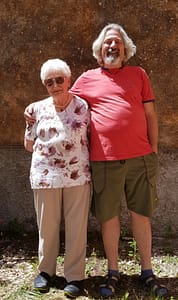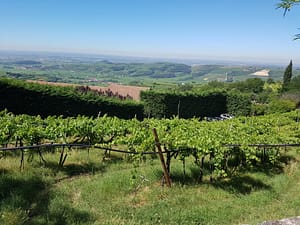Filippo Filippi is a top producer; not only of a high esteem, but the vineyards are also the highest in Soave. (See an earlier post.) Compared to other regions it’s not very high, only 400-something, but combined with the cool winds and the soils it’s just enough to give freshness to the wines.
We are in Castelcerino, a district (‘frazione’ in Italian) of the small, picturesque Soave town. This is the northernmost part of the wine area. It borders with the Val d’Alpone to the east, the last of a series of parallel valleys in the Verona province that brings cool air down from the pre-Alp Lessini mountains. To the east of the valley is the Monte Calvarino, where there was a underwater volcano. You can read more about this and see some pictures in the article about Gambellara. While the ground in Gambellara, Vicenza province, is almost entirely volcanic, Verona is more varied. But there is a lot in the eastern part of Verona too.
Filippo and his mother
The estate has belonged to the family since the 12th Century, but the winegrowing didn’t start untill a hundred years ago or so. Most of the around 20 hectares of vineyards were planted in the 1950’s, and the farming is now biodynamic. When we say family, there are really two. The company’s official name is Visco & Filippi, the former being the family name of Filippo’s mother.
Monteseroni, an 80 year old vintage, with Soave town in the background
We were walking around the beautiful estate. Here it’s almost like time has stood still, quiet, except for the sounds from the crickets and some birds, and very different from the A4 motorway and the Soave-San Bonifacio exit we passed only 5 minutes ago. There is forest all around.
Here it smells of wildflowers and herbs, such as mint and rosemary. Colleague blogger Emma Bentley, who worked here for a few years, tells in a blogpost that she is is astounded by the wildlife in the woods: “I’ve spotted deer, grouse and a snake and seen traces of wild boar. Turns out that wild boar like to munch on any low-hanging grapes…”
As you have already seen, the family has a long and deep relationship with this beautiful and historic property. So it’s no wonder that Filippo is more focused on expressing the virtues of each plot and their individual characteristics, rather than promoting the DOC Soave. There are many others who take care of that, we could add. To achieve his goals he sticks to the principles of old vines, organic farming and low yields, again contrary to many others in the area.
Filippo is a fan of the ‘pergola veronese’ binding method. It’s perfect for garganega, because this variety is very productive, so it is protected by the leaves. He has introduced Guyot in some of his sites too, to see how it works.
Vigne della Brà with its togo soil. The highest part has more clay. In the landscape there are also cricket sounds the bee is an indicator that the soil is organic
In the cellar too, it’s mostly a low-intervention attitude. Though some modern techniques are used, such as temperature-controlled steel vats, and some movements by gravity. But generally it’s just like in the old days; in the ageing room the temperatures vary according to the seasons. On the question if it’s easy to get the fermentation going, Filippo laughs and says no: “piano, piano” (‘wait’) he adds.
The Castelcerino vineyard
The vineyards vary considerably in composition, including soils of basalt, limestone, sand, and clay in the property’s five parcels: Castelcerino, Vigne della Brà, Monteseroni, Turbiana, and Calprea.
For the tasting Filippo presented a map of the vineyards, and a stone that represented the most dominant soil on each plot. Here are some brief comments.
We started with Castelcerino 2016, a garganega from two parcels at 320 meters of volcanic soil, and southeast exposure. The wine is made in stainless steel vats. It’s light in colour with a yellowish (or: slightly brown) tinge; aromas of apples, white flowers, almonds; very tasteful, slightly bitter in the aftertaste (a garganega feature), mineral salt (from the volacanic soil), and with 3 grams residual sugar it was rounded off against the acidity. He works with fine lees in all the wines, mostly 8-9 months, but one wine stayed on the lees for no less than 56 months. It doesn’t masque the terroir, according to Filippi, because the character of soil and grape are that strong.
Vigne della Brà 2016 comes from a 60-70 year old vineyard at 380 meters, with southwestern exposure. The soils shifts between clay and sand, with some basalt and limestone. Like the former wine it’s a varietal garganega elevated in steel. It stayed there for 14 months on the lees. The appearance is light and clear; aromas of apples, flowers, mint, melissa; more acidity than the previous wine, refreshing, and with a slight bitterness. It was not filtered, not clarified, but it had been moved between different vessels a couple of times before a late bottling. It’s not very unlike the former, but more acidic, refined and elegant.
Monteseroni 2016 is from the estate’s warmest site, the south-exposed vinayard at 350 meters, with mostly calcareous soils. It was accordingly more yellow in colour; more mature apples in the aroma, together with flowers and herbs. We can say that it was a bit “wilder”. It was also fuller, pure and tasty and long, but with less acidity as the Brà. In general this vineyard has 70-80 year old vines, but some are younger. The soil is calcareous.
Turbiana 2016: This is the trebbiano di Soave (also called ‘turbiana’) from that highest elevated vineyard at around 400 meters. The soil here is very poor, rocky and sandy, and the yields are low. It’s elevated in stainless steel, where it has contact with the lees for at least 6 months. Light in colour; mature apples and mint on the nose; round and balanced, with a natural acidity. It has the lowest quantity of SO2 of all his wines.
After this we tried some Castelcerino wines to see how they were developing: Castelcerino 2015 (from the part called “drio casa”): Yellow; honeyed at the beginning, spices, white fruites, medium full, mineral, salt. Castelcerino 12 “56 mesi sui lieviti – Foglio 1”. You have now guessed that this was the 56 months on the lees wine that I talked about. The designation “foglio 1” means that this was the first vineyard to be mapped in the Soave commune (at that time it was called Alberti, by the way). Filippo proudly shows me that map as evidence. The wine: Yellow colour; mature apples, followd by rounded citrus like clementines, and some notes of apricot/nectarines and mynth; grapey and round in the mouth and genereally elegant.
We also had a glance the other way, towards the future, with tank samples of Castelcerino and Vigne della Brà 2017. This was a hotter year, with some hail in the end of august. This showed in the samples, but this is just the way it is.
See the other posts in my Veneto series:
#1 – Maule’s Masieri
#2 – Prosecco in Verona’s Osteria la Manzorla
#3 – Gambellara: Maule and the two Davides
#4 – Zýmē’s Recioto Amandorlato
#5 – Vicenza province I: Tenuta l’Armonia
#6 – Vicenza province II: Siemàn
#7 – A Durella sparkling







